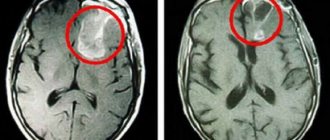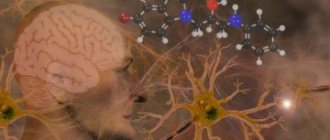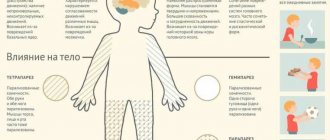Prison experiment
Philip Zimbardo conducted an interesting experiment called the Stanford Prison Experiment. Planned for two weeks, it was stopped after 6 days. The psychologist wanted to understand what happens when a person’s individuality and dignity are taken away - as happens in prison.
Article on the topic TEST: Your personality type
Zimbardo hired 24 men, whom he divided into two equal groups and assigned roles - prisoners and guards, and he himself became the “prison warden.” The surroundings were appropriate: the guards wore uniforms, and each had a baton, but the “criminals,” as befits people in such a situation, were dressed in poor overalls, they were not given underwear, and an iron chain was tied to their leg - as a reminder about prison. There was no furniture in the cells - only mattresses. The food was also not particularly special. In general, everything is true.
Prisoners were kept in cells designed for three people around the clock. The guards could go home at night and generally do whatever they wanted with the prisoners (except for corporal punishment).
The very next day after the start of the experiment, the prisoners barricaded the door in one of the cells, and the guards poured foam from a fire extinguisher on them. A little later, a VIP chamber was created for those who behaved well. Very soon the guards began to play games: they forced the prisoners to do push-ups, strip naked and clean the latrines with their hands. As punishment for riots (which, by the way, prisoners regularly organized), their mattresses were taken away. Later, a normal toilet became a privilege: those who rebelled were not allowed out of the cell - they were only brought a bucket.
Approximately 30% of the guards were found to have sadistic tendencies. Interestingly, the prisoners also became accustomed to their role. At first they were promised to give them 15 dollars daily. However, even after Zimbardo announced that he would not pay the money, no one expressed a desire to be released. People voluntarily decided to continue!
On the seventh day, a graduate student visited the prison: she was going to conduct a survey among the subjects. The picture simply shocked the girl - she was shocked by what she saw. After looking at the reaction of an outsider, Zimbardo realized that things had gone too far and decided to end the experiment early. The American Psychological Association has strictly forbidden it from ever being repeated for ethical reasons. The ban is still in effect.
TEST: Are you a powerful person?
Read more
Often the researcher is forced to specifically evoke manifestations of the child’s psyche that interest him. This is what the psychological experiment is aimed at.
Psychological experiment (Latin experimentum - attempt, experience) - a specially organized form of research into mental development
child
In an experiment, the researcher deliberately creates and modifies the conditions for a child’s activity, sets certain tasks for him and, based on how these tasks are solved, draws conclusions about his psychological characteristics.
The conditions of the experiment are determined by its methodology, contains a statement of the goal, a description of the material, the research process, and data processing criteria. All elements of the methodology are subordinated to the purpose of the study, for example. For example, if an experiment requires pictures on a white background, you should not use another one, as this may cause background reactions. And when children’s reactions to background stimuli are studied, the pictures are specially made on a colored background.
The instructions for the experiment (statement of the problem) are learned by heart and, if necessary, told to the child. The choice of material and the wording of the instructions ensure the standardization of the study, allow it to be repeated and cause the same type of phenomena, check and clarify the data obtained. Therefore, experiment is a more objective method than observation. Varying its conditions helps to identify patterns and mechanisms of mental development. The active position of the researcher, clear criteria for recording the analysis and results are prerequisites for the accumulation and processing of factual material. The experimental data are subjected to mathematical processing and expressed in numerical terms. In an experiment, the researcher mainly deals with only one side of the child’s psyche, so one should not make hasty conclusions without studying the other sides, which can lead to the development of one-sided ideas about her psyche.
The results of each experiment are recorded in a protocol, which indicates general information about the subjects, the objectives of the experiment, its conduct, data about the experimenter, quantitative and qualitative results of the experiment, features of the subjects’ behavior (actions, speech, expressive movements, etc.).
The most accurate and conclusive is a laboratory experiment, which is carried out in a specially equipped room using various instruments and installations (devices on which the experimenter shows Inca cards, turns on light bulbs, bells and other stimuli). The child is placed in a specially equipped chamber, where she takes a certain place in front of a screen or at a table. Sometimes sensors are attached to her body, detect changes in the child’s vascular, muscular, and nervous systems and transmit signals to special recording devices. In this case, registrations are used, i.e. recorders of time, force, speed and straightness of movements, excitation processes in the cerebral cortex that arise under the influence of a certain stimulus, and the general condition of the child. Such a study is unusual for a child; the experimenter does not see it, since he gives signals and observes her through special “eyes”.
In laboratory experiments, the characteristics of sensations and perceptions, the speed of reactions to stimuli, the amount of attention, etc. are studied. Data is measured and recorded with great objectivity and accuracy. However, in unusual laboratory conditions, a child may not show the same results as in natural conditions, so the data obtained are often limited. To make laboratory experiments natural, game simulations of experimental and life situations are used. For example, in the course of studying a child’s eye movements and other reactions, to record which it is necessary to attach sensors to her body, the experiment is organized like a group in astronauts.
natural experiment in child psychology is considered
proposed in 1910 by a famous Russian psychologist. Alexander. Lazursky (1874-1917). Unlike laboratory testing, it retains the advantages of observation (natural conditions) and eliminates distortions in mental manifestations. During it, the researcher is in an active position regarding the child, organizing, for example, a game with the aim of studying his strong-willed tote.
Natural experiments serve to study all mental processes and personality traits of preschool children. They are often used directly in a kindergarten group (the researcher acts as a teacher, organizing the children’s activities). At the same time, children do not suspect that the games and tasks that were offered to them have a specific research purpose. For example, children are given pictures that depict animals, cars, furniture, toys, and are asked to arrange them according to thematic focus. At the same time, the researcher has the opportunity to find out how they generalize, what signs they pay attention to in classes on p. Tarshish preschoolers to make a toy tell one group that children will play with it, the second - that they will give the toy to their mother, and the third - that it will be given to kids who do not have toys for children and this activity is not familiar, and helps the researcher determine the influence of various motives on the activities of infants and children.
The advantages of a natural experiment are evidenced by a study during which it is necessary to memorize and recall a number of words in a laboratory experiment situation and in a game situation, playing the role of a “buyer” ((buying necessary items in a “store”). Analysis of the results obtained showed that the memorization effect in the game is noticeably superior to the game.
The forming experiment is widely used in child psychology, during which the method of studying mental processes and qualities is to educate children, aimed at their formation or improvement.
Forming experiment. L. Vygotsky called the “experimental-genetic” method of research, believing that an objective study of the patterns of development of a mental process is possible only in the process of its formation. In pedagogical research, this method is called formal-formal.
A formative experiment is not identical to a pedagogical one, which is used to study the effectiveness of new programs, methods of teaching and raising children. Outwardly, they are similar, since in both cases children are hungry for something new, and a successful learning result is considered a confirmation of predictions. The difference lies in the nature of the forecasts: the psychologist envisages the features of mental processes, qualities, and personality traits that arise during development; teacher - the ways in which positive results can be achieved in teaching and raising children.
In studies conducted under the guidance of a domestic psychologist. Alexandra. Zaporozhets (1905-1981), the molding experiment was used to test the hypothesis that under certain conditions it is possible to raise perception processes to a qualitatively new level and develop individual aspects of the child’s sensory. As it turned out, preschoolers find it difficult to distinguish sounds by pitch. To develop this ability, the following veterinary exercise was carried out: dramatization scenes were played out in front of the children, in which a large “daddy bear” took part, producing low sounds, and a “mama bear”, which was smaller and producing high-pitched sounds. Then the experimenter, together with the children, acted out episodes from the lives of these characters: the “bears” were hiding in different places, and the child had to find them by their voices. It turned out that after such training, even small children (2-4 years old) begin not only to easily distinguish the pitch of the voices of characters, but also successfully note the difference between any sounds they hear for the first time and are completely unrelated to objects known to them. .
One study combines different types of experiment. First, a regular ascertaining experiment is organized to record the level of development of the mental process and quality of development in children under normal conditions. Then they resort to a molding experiment in order to obtain a new level of mental process, quality according to predictions. The research is completed by a simple, but controlled experiment, designed to find out the changes that occurred as a result of the experimenter’s formation.
The organization of an experimental study must meet certain requirements. At the stage of planning an experiment, it is necessary to clearly formulate its goals, determine the sample of the study (participants), think over and write down the methods for conducting it, determine the conditions in which it will take place (place and time), select the conditions and rules of the game under which the most characteristic personality qualities of D. Itin. The room in which the experiment will be carried out should be familiar to the child and not contain unnecessary objects that could distract his attention; therefore, you should not use a sports hall, theater room, zoological room, etc. for it. It is important to take care of its lighting and avoid extraneous stimuli (sounds, smells, new objects). You should not sit your child facing the window so as not to eat.
In the experiment, a friendly relationship should be established with the child participating in the study. To do this, you need to sit her next to you, and not across the table. In communication, it is not advisable to sharpen the child’s attention to mistakes, or to react restrainedly and evenly to her successes and failures during the experiment. The pace of the experiment must correspond to the individual psychological characteristics of the infant.
The study should not be long (10-20 minutes). Signs of overwork, boredom, and the child’s reluctance to carry out further tasks are grounds for stopping it. The experiment always involves standard procedures, so no changes should be made to the process of its implementation. In a preschool institution, experimental studies are carried out in the afternoon.
Invisible Gorilla
Perceptual blindness is a phenomenon when a person is so overwhelmed with impressions that he does not notice anything around him. Attention is completely absorbed by only one object. Each of us suffers from this type of visual blindness from time to time.
Article on the topic
Absent-mindedness - the ghost of genius? Exercises for concentration
Daniel Simons showed subjects a video of people wearing black and white T-shirts throwing a ball to each other. The task was simple - count the number of throws. While two groups of people were throwing a ball, a man dressed in a gorilla suit appeared in the center of the sports ground: he pounded his chest with his fists, just like a real monkey, and then calmly walked away from the field.
After watching the video, participants in the experiment were asked if they noticed anything strange on the site. And as many as 50% answered negatively: half simply did not see the huge gorilla! This is explained not only by our focus on the game, but also by the fact that we are not ready to see something incomprehensible and unexpected in ordinary life.
Sources
- Nikandrov V.V.
Observation and experiment in psychology. St. Petersburg: Rech, 2002 - Research in psychology: methods and planning / J. Goodwin. St. Petersburg: Peter, 2004. P. 172.
- Zarochentsev K. D., Khudyakov A. I.
Experimental psychology: textbook. - M.: Prospekt, 2005. P. 74. - See also there. P. 51.
- Gottsdanker R.
Fundamentals of psychological experiment. M.: MGPPIA, 1982. P. 51-54. - Zarochentsev K. D., Khudyakov A. I.
Experimental psychology: textbook. P. 74. - See also there. pp. 76-77.
- Druzhinin V. N.
Experimental psychology. — 2nd ed., add. - St. Petersburg: Peter, 2002. pp. 78-85. - Zarochentsev K. D., Khudyakov A. I.
Experimental psychology: textbook. P. 50.
Killer teachers
Stanley Milgram is famous for his outrageous, hair-raising experiment. He decided to study how and why people obey authority. The psychologist was prompted to do this by the trial of Nazi criminal Adolf Eichmann . Eichmann was accused of ordering the extermination of millions of Jews during World War II. Lawyers built a defense based on the assertion that he was just a military man and obeyed the orders of his commanders.
Milgram advertised in the newspaper and found 40 volunteers, ostensibly to study memory and learning abilities. Everyone was told that someone would be a teacher and someone would be a student. And they even held a draw so that people would take what was happening at face value. In fact, everyone got a piece of paper with the word “teacher” on it. In each pair of experimental subjects, the “student” was an actor who acted in concert with the psychologist.
TEST: Are you able to be patient?
Read more
So, what was this shocking experiment?
1. The “student,” whose task was to remember the words, was tied to a chair and electrodes were connected to his body, after which the “teacher” was asked to go to another room.
Article on the topic
TEST: Can you be cunning?
2. In the “teacher’s” room there was an electric current generator. As soon as the “student” made a mistake while learning new words, he had to be punished with an electric shock. The process began with a small discharge of 30 volts, but each time it increased by 15 volts. The maximum point is 450 volts.
So that the “teacher” does not doubt the purity of the experiment, he is given an electric shock with a voltage of 30 volts - quite noticeably. And this is the only real category.
3. Then the fun begins. The “student” remembers the words, but soon makes mistakes. Naturally, the experimental “teacher” punishes him, as required by the instructions. With a discharge of 75 volts (fake, of course), the actor groans, then squeals and begs to be untied from the chair. Each time the current increases, the screams only get louder. The actor even complains of heart pain!
4. Of course, people were scared and wondered whether it was worth continuing. Then they were clearly told not to stop under any circumstances. And the people obeyed. Although some trembled and chuckled nervously, many did not dare to disobey.
5. At the 300 volt mark, the actor furiously pounded the wall with his fists and shouted that he was in great pain and could not bear this pain; at 330 volts it died down completely. Meanwhile, the “teacher” was told: since the “student” is silent, this is the same as an incorrect answer. This means that the silent “student” must be shocked again.
7. The experiment ended when the “teacher” chose the maximum discharge of 450 volts.
The findings were terrible: 65% of the participants reached the highest point and the “draconian” figures of 450 volts - they applied a discharge of such force to a living person! And these are ordinary, “normal” people. But under pressure from authority, they subjected those around them to suffering.
Milgram's experiment is still criticized for being unethical. After all, the participants did not know that everything was for fun, and experienced serious stress. No matter how you look at it, causing pain to another person results in psychological trauma for life.
Drawing from Paul Kleinman's book Psychology. Publishing house "Mann, Ivanov and Ferber".
Content
- 1 Specifics of a psychological experiment
- 2 General information 2.1 The main objective of the experimental study
- 2.2 Validity in a psychological experiment
- 3.1 Depending on the method of conduct
- 4.1 The Perfect Experiment
Heinz's dilemma
Psychologist Lawrence Kohlberg studied moral development. He believed that this is a process that continues throughout life. To confirm his guesses, Kohlberg presented children of different ages with complex moral dilemmas.
The psychologist told the children a story about a woman who was dying - cancer was killing her. And by a stroke of luck, one pharmacist allegedly invented a medicine that could help her. However, he asked for a huge price - $2,000 per dose (although the cost of manufacturing the medicine was only $200). This woman's husband - his name was Heinz - borrowed money from friends and collected only half the amount, $1,000.
Article on the topic
TEST: What kind of animal are you?
Arriving at the pharmacist, Heinz asked him to sell the medicine for his dying wife cheaper, or at least on credit. However, he replied: “No! I created a cure and I want to get rich." Heinz fell into despair. What was to be done? That same night he secretly entered the pharmacy and stole the medicine. Did Heinz do a good job?
This is the dilemma. Interestingly, Kohlberg did not study the answers to the question, but the reasoning of the children. As a result, he identified several stages in the development of morality: starting from the stage when the rules are perceived as absolute truth, and ending with the observance of one’s own moral principles - even if they run counter to the laws of society.










